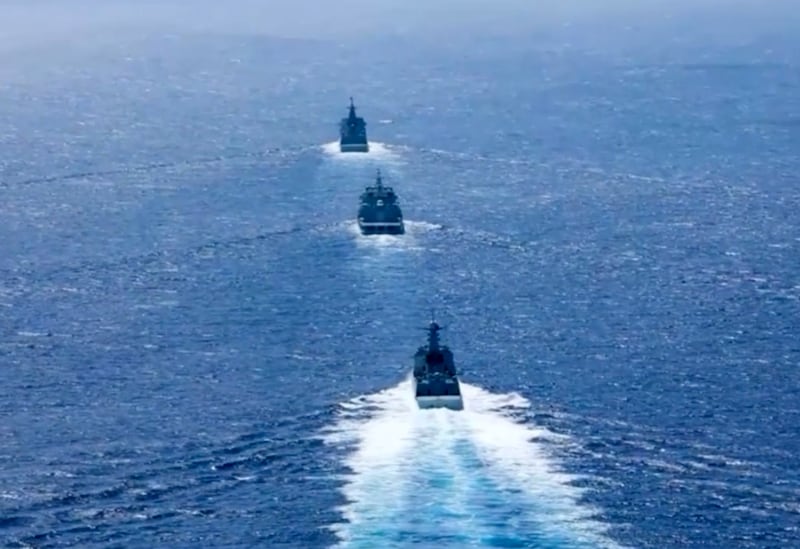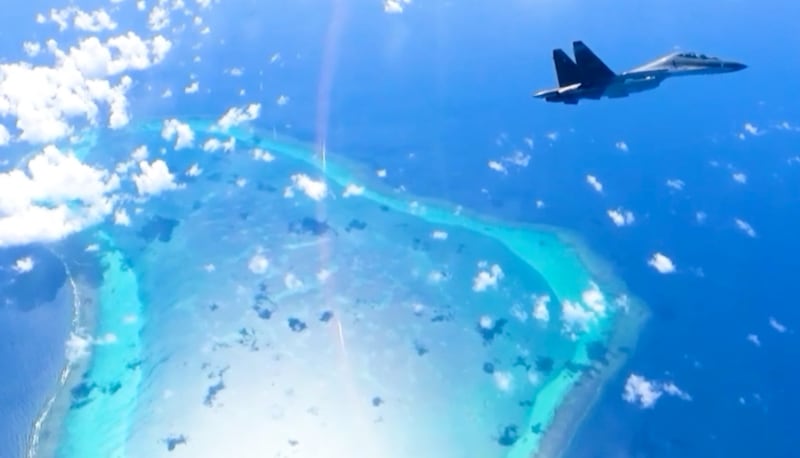MANILA – The Chinese military’s Southern Theater Command has staged a large-scale combat readiness exercise around the disputed Scarborough Shoal in the South China Sea, the ministry of defense in Beijing said.
Personnel from China’s navy and air force, as well as the coast guard, took part in Sunday’s drills at the group of reefs that China refers to as Huangyan Dao, with a U.S. Navy ocean surveillance ship spotted in the area.
The ministry said that since the beginning of the month, the Southern Theater Command “has organized its naval and air force troops to continuously strengthen maritime and airspace patrols” around the shoal.
Scarborough Shoal is known in the Philippines as Bajo de Masinloc, and is well inside its exclusive economic zone, just 125 nautical miles (232 kilometers) from the main Philippine island of Luzon.
RELATED STORIES
Philippines, US, Japan stage joint naval maneuvers in South China Sea
Philippines enacts laws asserting maritime claims
Philippines says it did not surrender Sabina Shoal to China
In a video clip released by the Chinese Command, several military aircraft including two Su-30 fighter jets, an H-6K bomber and a Shaanxi Y-8 transport plane, were seen flying over the reefs while at least three naval ships led by the 11,000-ton Type 055 large destroyer Xianyang were also present.

“This is China flexing its muscle and making a statement about its claim of territorial sovereignty over Scarborough Shoal,” said Ray Powell, a U.S. maritime analyst and director of the SeaLight project at Stanford University.
“Looking at 2024 as a whole, we’ve seen China pass new policy enabling its coast guard to detain border violators for up to 60 days and establish straight baselines around Scarborough Shoal to bolster its case that it is Chinese territory,” Powell told Radio Free Asia, adding that Beijing has also increased its regular coast guard and maritime militia presence to push Philippine coast guard and fisheries patrols further away, and increased its military presence.
“Beijing is putting real teeth behind its ‘indisputable sovereignty’ claim over the shoal,” he said.
No more ‘gray zone’
Powell spotted the USNS Victorious, a U.S. Military Sealift Command ocean surveillance vessel, patrolling nearby, apparently to monitor the Chinese exercise.
“I don’t think we can be sure, but it seems very timely. I can’t think of another reason it would have tarried there at that time unless it was to surveil China’s patrol,” he told RFA.
The United States is the Philippines’ treaty ally and has repeatedly condemned China’s aggression in the waters over which China claims the lion’s share. China’s claims were rejected by an international tribunal in 2016 and are being disputed by other littoral states.
Manila has yet to respond to Beijing’s latest activities but the Philippine army chief said this month that China had “upscaled its presence” in the West Philippine Sea, referring to the area of South China Sea under Philippine jurisdiction.
Gen. Romeo Brawner Jr., chief of the armed forces, told an RFA reporter in Manila that his office had adopted an acronym for Chinese activities in the region – ICAD, or illegal, coercive, aggressive and disruptive, actions – instead of gray zone activities.
Gray zone tactics are aggressive actions that jeopardize a nation’s security but are under the threshold of war and therefore difficult to respond to.

The Philippine military’s new strategy is to set up an effective presence in the West Philippine Sea with a “whole nation approach,” with all sectors of society taking part in the maritime strategy, according to Brawner.
“The Philippines lacks the maritime capability to directly challenge China’s effective control of Scarborough Shoal,” said Stanford’s Powell.
“It will have to press its case on the international stage that China’s actions have violated international law by denying Philippine fishermen access to the shoal and by permitting environmental destruction of the shoal by its own fishermen through their illegal giant clam harvesting,” the analyst added.
In 2016 Manila brought Beijing to a U.N. arbitral tribunal which ruled that almost all China’s claims in the South China Sea were illegal and therefore invalid. China refused to take part and rejected the ruling.
The Philippine government, however, is considering a new legal case against China for its violations of the U.N. Convention on the Law of the Sea and is seeking support from other nations, sources told RFA.
Edited by Mike Firn.
